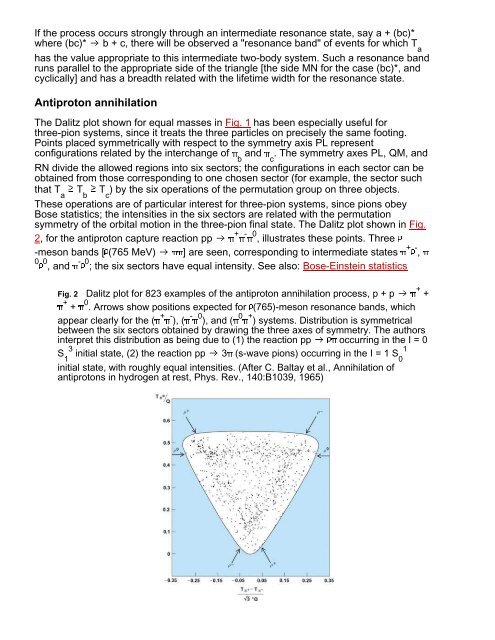Dalitz plot - F9
Dalitz plot - F9
Dalitz plot - F9
You also want an ePaper? Increase the reach of your titles
YUMPU automatically turns print PDFs into web optimized ePapers that Google loves.
If the process occurs strongly through an intermediate resonance state, say a + (bc)*where (bc)* b + c, there will be observed a "resonance band" of events for which T ahas the value appropriate to this intermediate two-body system. Such a resonance bandruns parallel to the appropriate side of the triangle [the side MN for the case (bc)*, andcyclically] and has a breadth related with the lifetime width for the resonance state.Antiproton annihilationThe <strong>Dalitz</strong> <strong>plot</strong> shown for equal masses in Fig. 1 has been especially useful forthree-pion systems, since it treats the three particles on precisely the same footing.Points placed symmetrically with respect to the symmetry axis PL representconfigurations related by the interchange of band c. The symmetry axes PL, QM, andRN divide the allowed regions into six sectors; the configurations in each sector can beobtained from those corresponding to one chosen sector (for example, the sector suchthat T aT bT c) by the six operations of the permutation group on three objects.These operations are of particular interest for three-pion systems, since pions obeyBose statistics; the intensities in the six sectors are related with the permutationsymmetry of the orbital motion in the three-pion final state. The <strong>Dalitz</strong> <strong>plot</strong> shown in Fig.+ - 02, for the antiproton capture reaction pp , illustrates these points. Three-meson bands [ (765 MeV) ] are seen, corresponding to intermediate states + - ,0 0 - 0 , and ; the six sectors have equal intensity. See also: Bose-Einstein statisticsFig. 2 <strong>Dalitz</strong> <strong>plot</strong> for 823 examples of the antiproton annihilation process, p + p+ 0 + . Arrows show positions expected for (765)-meson resonance bands, whichappear clearly for the ( + - ), ( - 0 ), and ( 0 + ) systems. Distribution is symmetricalbetween the six sectors obtained by drawing the three axes of symmetry. The authorsinterpret this distribution as being due to (1) the reaction pp occurring in the I = 03 1S initial state, (2) the reaction pp 3 (s-wave pions) occurring in the I = 1 S0 1initial state, with roughly equal intensities. (After C. Baltay et al., Annihilation ofantiprotons in hydrogen at rest, Phys. Rev., 140:B1039, 1965)+ +















